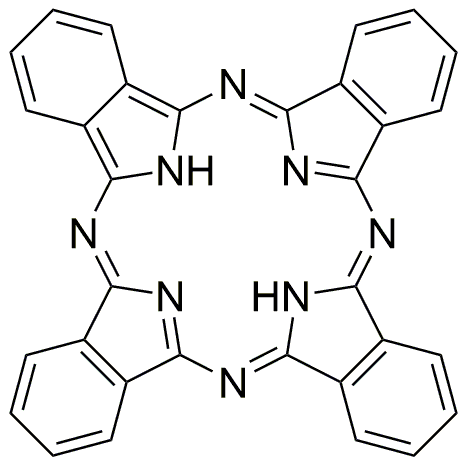Phthalocyanine is widely utilized in research focused on:
- Dyes and Pigments: Commonly used in the textile and printing industries, phthalocyanine provides vibrant colors and excellent lightfastness. Its stability makes it a preferred choice for high-quality inks and coatings.
- Photodynamic Therapy: In the medical field, phthalocyanine compounds are utilized in photodynamic therapy for cancer treatment. They can selectively target cancer cells and, when activated by light, produce reactive oxygen species that destroy these cells.
- Electronics: Phthalocyanine is used in the production of organic semiconductors, which are essential for devices like organic light-emitting diodes (OLEDs) and solar cells. Its excellent electrical conductivity enhances the efficiency of these technologies.
- Catalysis: In chemical synthesis, phthalocyanine acts as a catalyst in various reactions, improving reaction rates and selectivity. This application is particularly valuable in the production of fine chemicals and pharmaceuticals.
- Environmental Applications: Phthalocyanine complexes are employed in environmental monitoring as sensors for detecting pollutants. Their ability to interact with various chemical species makes them effective in assessing air and water quality.
General Information
Properties
Safety and Regulations
Applications
Phthalocyanine is widely utilized in research focused on:
- Dyes and Pigments: Commonly used in the textile and printing industries, phthalocyanine provides vibrant colors and excellent lightfastness. Its stability makes it a preferred choice for high-quality inks and coatings.
- Photodynamic Therapy: In the medical field, phthalocyanine compounds are utilized in photodynamic therapy for cancer treatment. They can selectively target cancer cells and, when activated by light, produce reactive oxygen species that destroy these cells.
- Electronics: Phthalocyanine is used in the production of organic semiconductors, which are essential for devices like organic light-emitting diodes (OLEDs) and solar cells. Its excellent electrical conductivity enhances the efficiency of these technologies.
- Catalysis: In chemical synthesis, phthalocyanine acts as a catalyst in various reactions, improving reaction rates and selectivity. This application is particularly valuable in the production of fine chemicals and pharmaceuticals.
- Environmental Applications: Phthalocyanine complexes are employed in environmental monitoring as sensors for detecting pollutants. Their ability to interact with various chemical species makes them effective in assessing air and water quality.
Documents
Safety Data Sheets (SDS)
The SDS provides comprehensive safety information on handling, storage, and disposal of the product.
Product Specification (PS)
The PS provides a comprehensive breakdown of the product’s properties, including chemical composition, physical state, purity, and storage requirements. It also details acceptable quality ranges and the product's intended applications.
Certificates of Analysis (COA)
Search for Certificates of Analysis (COA) by entering the products Lot Number. Lot and Batch Numbers can be found on a product’s label following the words ‘Lot’ or ‘Batch’.
Numéro de catalogue
Numéro de lot/série
Certificates Of Origin (COO)
This COO confirms the country where the product was manufactured, and also details the materials and components used in it and whether it is derived from natural, synthetic, or other specific sources. This certificate may be required for customs, trade, and regulatory compliance.
Numéro de catalogue
Numéro de lot/série
Safety Data Sheets (SDS)
The SDS provides comprehensive safety information on handling, storage, and disposal of the product.
DownloadProduct Specification (PS)
The PS provides a comprehensive breakdown of the product’s properties, including chemical composition, physical state, purity, and storage requirements. It also details acceptable quality ranges and the product's intended applications.
DownloadCertificates of Analysis (COA)
Search for Certificates of Analysis (COA) by entering the products Lot Number. Lot and Batch Numbers can be found on a product’s label following the words ‘Lot’ or ‘Batch’.
Numéro de catalogue
Numéro de lot/série
Certificates Of Origin (COO)
This COO confirms the country where the product was manufactured, and also details the materials and components used in it and whether it is derived from natural, synthetic, or other specific sources. This certificate may be required for customs, trade, and regulatory compliance.


